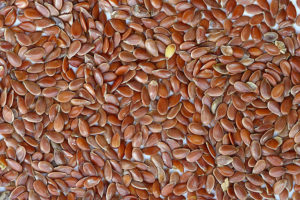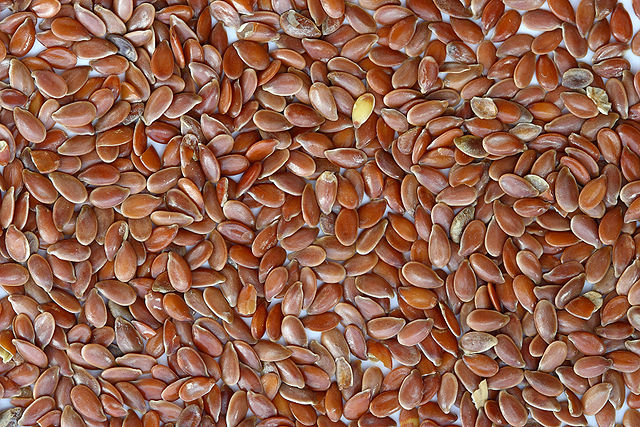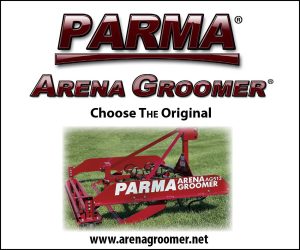By Juliet M. Getty, Ph.D.
Do you feed your horse flaxseeds? You likely do. Good job! Flaxseeds are a wonderful source of fat, quality protein, water-soluble fiber, and have amazing health benefits. Read on and get all the facts about this excellent whole food.
Flaxseeds are high in fat
 The type of fat is what makes them so special. What differentiates flaxseeds from other high fat foods is its fatty acid profile. Most of the fat in flaxseeds is in the form of two polyunsaturated fatty acids — linoleic acid (LA) and alpha-linolenic acid (ALA). Your horse requires them to be healthy. But his body is not capable of producing them. (The same is true for you!) So, it is up to you to add them to his diet. Consequently, by definition, LA and ALA are referred to as essential fatty acids (EFAs).
The type of fat is what makes them so special. What differentiates flaxseeds from other high fat foods is its fatty acid profile. Most of the fat in flaxseeds is in the form of two polyunsaturated fatty acids — linoleic acid (LA) and alpha-linolenic acid (ALA). Your horse requires them to be healthy. But his body is not capable of producing them. (The same is true for you!) So, it is up to you to add them to his diet. Consequently, by definition, LA and ALA are referred to as essential fatty acids (EFAs).
LA belongs to the omega-6 family of fatty acids and comprises 16% of flaxseed’s fatty acid content. Inside the horse’s cells, it is converted to arachidonic acid, which promotes the formation of inflammatory prostaglandins and eicosanoids.
ALA is one of several omega-3 fatty acids and comprises 58% of flaxseed’s fat content. It has the opposite effect on inflammation – it reduces inflammation because it enters a different metabolic pathway, leading to the formation of an anti-inflammatory omega-3 fatty acid known as docosahexaenoic acid (DHA).[i] However, it has been suggested that this conversion rate of ALA to DHA is low.[ii] Nevertheless, the amount of DHA produced may be sufficient to maintain tissue function and may not be a concern unless the horse is experiencing significant amounts of inflammation. For example, horses suffering from arthritis, obesity, insulin resistance, leptin resistance, PPID, ulcers, allergies, muscle soreness, ligament/tendon damage, and injuries, would likely benefit from adding DHA directly to the diet.[iii]
Further dscussion of fatty acid metabolism is complex and beyond the scope of this article. Suffice it to say, that the addition of these two EFAs is critical to your horse’s health. Furthermore, they need to be in the proper proportion to each other.
What is the correct ALA to LA ratio and how much does your horse need?
The ideal ratio of ALA to LA has not been formally established. It makes sense, however, to strive toward the ratio that naturally exists in pasture grasses. The average EFA level of grasses during warm growing seasons is 10 mg of ALA and 2.5 mg of LA per gram of dry matter.[iv] Therefore, this 4:1 ratio of ALA:LA is what horses would realistically consume in a wild setting.
The requirement of these two fatty acids is also unknown. However, if we use 22 lbs (10 kg) of pasture dry matter as a realistic consumption amount, the horse would ingest, on average, 100 grams of ALA and 25 grams of LA. Since many healthy horses do well with far less, it is reasonable to assume that their requirement is not this high. However, it helps us to appreciate how important it is for the diet to contain more ALA than LA. Unfortunately, hay no longer contains appreciable levels of EFAs and most commercial feeds have an inverted ratio with more LA than ALA.
Evaluate the ingredients in your feed
The phrase “vegetable oil” on the ingredient label refers to soybean oil. While soybean oil does have 7% ALA, it contains a whopping 54% in the form of LA. If you are relying on this feed to provide EFAs, it has an inverted ALA to LA ratio that potentially damages your horse’s health through excessive inflammation.
The terms “flaxseed” and “linseed” can be used interchangeably. However, be cautious of flaxseed or linseed “meal.” This denotes a product that has had most of its fat content removed through crushing (known as expeller pressed). Therefore, the product does not provide sufficient EFAs.[v] Look instead, for “ground” flaxseeds or linseeds.
Flaxseeds have many health advantages
Flaxseeds, as with any source of fat, aid in the absorption of fat soluble vitamins, A, D, E, and K, as well as other fat-soluble nutrients such as the increasingly popular turmeric (curcumin), boswellia, and resveratrol.
Flaxseeds are also a terrific way to add protein, thereby boosting the diet’s overall protein quality. When you offer a variety of protein sources, your horse’s body has a large, varied, amino acid pool from which to choose for building and repairing tissues.
Flaxseeds are low in sugar and starch (2.6%), making them safe for horses with insulin resistance, PPID (Cushing’s), and PSSM. They are high in fiber (47%) with a large amount of pectin and mucilage.[vi] These water-soluble fibers create a soothing gel inside the digestive tract.
Flaxseeds are low in potassium, making them appropriate to feed to horses with HYPP.
But they really shine because of their EFA content. One ounce (28.4 grams) of flaxseeds contains 6 grams of ALA and 1.6 grams of LA (4:1 ratio). These offer amazing health benefits for:
- immune function
- joints and ligaments integrity
- allergies to seasonal pollens and sweet itch (Culicoides hypersensitivity)[vii]
- heart and blood vessel health
- respiratory well-being
- digestive function and gastrointestinal health
- hair and hoof strength
- energy needs for athletes
- nervousness and behavior[viii]
- tying up prevention
- insulin resistance reduction[ix]
A word about the lignan content in flaxseeds
Flaxseeds are a rich source of lignans, plant chemicals that act similarly to estrogens in the body. They are found in the cell wall of many fiber-rich foods including berries, seeds, grains, nuts, and fruits. There are many studies to suggest that lignan metabolites provide health benefits due to their antioxidant and weak estrogenic activity, and may also reduce cancer risk. It has been suggested, however, that pregnant women should not over-consume flaxseeds.[x] Relative to broodmares, there does not appear to be any reason to avoid feeding flaxseeds and can be nutritious in moderation. Nevertheless, I generally tend to rely on other sources[xi] of omega 3s, such as chia seeds and algal DHA during pregnancy.[xii]
Whole or ground flaxseeds? Flaxseed oil?
Whole flaxseeds are wasteful. Flaxseeds are tiny, and are not adequately chewed, leaving an intact outer hull. As a result, two things can happen: The hindgut bacteria can digest the fibrous hull, and ferment the seeds’ contents. This would provide energy for your horse, but nothing more, since the EFAs cannot be absorbed from the cecum and large colon; or the whole seeds may escape digestion altogether and end up in the manure.
Ground flaxseeds provide the best bioavailable source of EFAs. If you grind them yourself, limit the amount to two or three days’ worth and store them in the refrigerator in a sealed container. Exposure to light, heat, and moisture will trigger an oxidative rancidity reaction, making them not only unpalatable, but unsafe to feed. Oxidation of EFAs creates free-radicals, molecules that are chemically missing an electron and will seek to obtain one by damaging tissues throughout the body.
Flaxseed oil is especially vulnerable to oxidation and starts to go rancid as soon as you let air into the bottle. Naturally occurring vitamin E is an antioxidant and will protect the EFAs from oxygen but will soon run out, leaving the fatty acids defenseless. Furthermore, the oil only provides fat, whereas the ground flaxseeds offer far more nutritive value.
Is there cyanide in flaxseeds?
Yes, but you would have to feed more than 2 lbs of raw flaxseeds for this to be a concern. Flaxseeds contain cyanogenic glucoside enzymes that, when activated by water, create cyanide gas.[xiii] Your horse’s stomach acid denatures (inactivates) these enzymes. Hot water also renders them inactive, but boiling flaxseeds is not recommended because it destroys the EFAs. Soaking whole seeds or ground raw seeds in cold water will cause this gas to be released. So, when adding your own ground flaxseeds to a moistened meal, add them last and feed immediately. Or better yet, choose a commercially stabilized ground flaxseed product[xiv] because the stabilization process exposes the ground flaxseeds to enough heat to inactivate these enzymes.
Measuring ground flaxseeds can be confusing
If your roduct’s directions are in “ounces” you must determine if they are describing “ounces by weight” or “ounces by volume.” For example, two ounces (by weight) of ground flaxseeds will fill a ½ cup measure (which is 4 fluid ounces in volume). In the directions below, I give you volumetric amounts to make things easier to measure. For my international readers, 2 ounces by weight would be the same as 57 grams and would fill a 120-ml measure.
Feeding directions
Horses who are not accustomed to eating ground flaxseed do best when it is introduced slowly, over a 2 to 3-week period, to allow the hind gut bacterial population time to adjust.
If your horse is getting at least 8 hours of fresh, healthy pasture during the growing seasons, you do not typically need to add any ground flaxseed, unless he is having health issues that would benefit from it.
During cold seasons and hay-based diets, I recommend the following amount of ground flaxseeds per day:
For an adult, 1100 lb (500 kg) horse (adjust for smaller or larger breeds):
- Maintenance, overweight: ¼ to ½ cup
- Maintenance, of healthy weight: ½ to 1 cup
- Maintenance, underweight: 1 cup to 1 ½ cups
- Working or performing horses: 1 ½ to 2 cups
For young and growing horses:
- Foals do best with a creep feeding approach:[xv] ¼ cup
- Yearlings and growing horses: ½ cup to 1 cup
For full-sized (1100 lbs) adult horses with health conditions[xvi] that warrant additional ground flaxseeds:
- Feed 2 cups, up to 4 cups (480-960 ml). Adjust amount to less than 1 cup if the horse is overweight and is not exercising.
- More than 2 cups per day should not be fed long term, but only until you see improvement. Then reduce to maintenance levels.
Ponies, donkeys, and minis
These animals are genetically predisposed toward becoming overweight and while dietary fat is important, it should be provided at more moderate levels than what you’d give to a full-sized horse. As with horses, EFAs must be in the diet because their bodies are not capable of producing them. Ground flaxseeds are worth adding in lesser amounts if the animal is not getting EFAs from pasture, supplements, or fortified feeds.
Bottom line
Essential fatty acids (EFAs) must be in the diet since they cannot be produced within the horse’s body. Pasture grazing during growing seasons offers plenty of EFAs. However, when hay is the primary forage source, EFAs must be supplemented. Ground flaxseeds offer an economical, palatable, and nutritious source of EFAs.
[i] The accumulation of EPA and/or DHA when ALA is fed has been shown in a variety of studies using cats, dogs, humans, and horses:
- Bauer, J.E., Dunbar, B.L., and Bigley, K.E., 1998. Dietary flaxseed in dogs results in differential transport and metabolism of omega -3 polyunsaturated fatty acids. Journal of Nutrition, 128(12), 26415-26445.
- Mantzioris, E., James, M.J., Gibson, R.A., and Cleland, L.G., 1994. Dietary substitution with an alpha linolenic acid-rich vegetable oil increases eicosapentaenoic acid concentration is tissues. The American Journal of Clinical Nutrition, 59(6), 1304-1309.
- Hansen, R.A., Savage, C.J., Reidlinger, K., Traub-Dargatz, J.L., Ogilvie, G.K., Mitchell, D., and Fettman, M.J., 2002. Effects of dietary flaxseed oil supplementation on equine plasma fatty acid concentrations and whole blood platelet aggregation. Journal of Veterinary Internal Medicine, 16, 457-463
[ii] Brenna, J.T., Salem, Jr., N., Sinclair, A.J., and Cunnane, S.C., 2009. Alpha-linolenic acid supplementation and conversion to omega-3 long-chain polyunsaturated fatty acids in humans. Prostaglandins, Leukotrienes, and Essential Fatty Acids, 80, 85-91. And Burdge, G.C., and Calder, P.C., 2005. Conversion of alpha-linolenic acid to longer-chain polyunsaturated fatty acids in human adults. Reproductive Nutritional Development, 45, 581-597.
[iii] Supplements containing DHA can be found in Dr. Getty’s Free Shipping Supplement Store, http://horsesupplements.gettyequinenutrition.biz
[iv] Wyss, U., Morel, I., and Collomb, M., 2006. Fatty acid content of three grass/clover mixtures. Grassland Science in Europe, vol. 11, 348-350.
[v] Content provided by Feedipedia, Linseed Meal. https://www.feedipedia.org/node/735
[vi] Cloe, A. Soluble fiber in flaxseeds. https://healthyliving.azcentral.com/soluble-fiber-flaxseed-17010.html
[vii] O’Neill, W., McKee, S., and Clarke, A.F., 2002. Flaxseed (Linum usitatissimum) supplementation associated with reduced skin test lesional area in horses with Culicoides hypersensitivity, The Canadian Journal of Veterinary Research, 66, 272-277.
[viii] Holland, J.L., Kronfeld, D.S., and Meacham, T.N., 1996. Behavior of horses is affected by soy lecithin and corn oil in the diet. Journal of Animal Science, 74, 1252-1255.
[ix] Brennan, K.M., Graugnard, D.E., Spry, M.L., Brewster-Barnes, T., Smith, A.C., Schaeffer, R.E., and Urschel, K.L., 2015. Effects of docosahexaenoic acid-rich microalgae nutritional product on insulin sensitivity after prolonged dexamethasone treatment in healthy mature horses. American Journal of Veterinary Research, 76(10), 889-896. And, Mogos, T., Dondoi, C., Chelan, C.V., Iacobini, A., and Buzea, M., 2014. Effect of omega-3- fatty acids treatment on insulin resistance. Romanian Journal of Diabetes, Nutrition, and Metabolic Diseases, 21(4), 269-276.
[x] Adolphe, J.L., Whiting, S.J., Juurlink, B. H.J., Thorpe, L.U., and Alcorn, J., 2009. Health effects with consumption of the flax lignan secoisolariciresinol diglucoside. British Journal of Nutrition, 103, 929-938.
[xi] Getty, J.M., 2016. Omega 3 supplements – the old and the new. http://gettyequinenutrition.biz/Library/Omega3Supplements.htm.
[xii] Adkin, A.M., Muniz, A.V., Mortensen, C.J., & Warren, L.K. 2015. Maternal fatty acid supplementation influences memory and learning ability in yearling and 2-year-old horses. Journal of Equine Veterinary Science, 35(5), 419.
[xiii] Richards, N., 2011. Feeding Flax. Newsletter #22, http://feedxl.com/newsletters/22-feeding-flaxseed.html
[xiv] Nutra Flax (Horsetech) is worth considering – http://gettyequinenutrition.biz/products/nutraflax.htm as well as other commercially stabilized ground flaxseed products.
[xv] Creep feeding is discussed in: Getty, J.M., 2009. Feed Your Horse Like A Horse, Chapter 19, page 348-349.
[xvi] Health conditions that improve with EFA supplementation include (but not limited to): insulin resistance, PPID, leptin resistance, joint and ligament disease or injury, muscle soreness, ulcers, recurrent colic, diarrhea, dermatitis, respiratory ailments, allergies, uveitis, laminitis, white line disease, thrush, hoof cracks, stress, exercise recovery, poor hair coat, hair loss, and sensitive behaviors. Overweight horses also benefit due to EFA’s anti-inflammatory properties, but should be fed lesser amounts due to their high calorie content.

Juliet M. Getty, Ph.D. is an independent equine nutritionist with a wide U.S. and international following. Her research-based approach optimizes equine health by aligning physiology and instincts with correct feeding and nutrition practices. Dr. Getty’s goal is to empower the horseperson with the confidence and knowledge to provide the best nutrition for his or her horse’s needs. Learn more at www.gettyequinenutrition.com.






